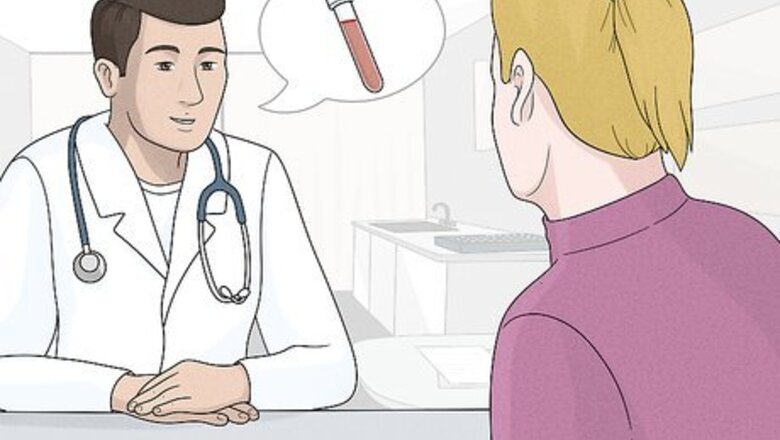
views
X
Trustworthy Source
Mayo Clinic
Educational website from one of the world's leading hospitals
Go to source
Studies show that unhealthy eating habits, inactivity, and smoking increase your risk of high cholesterol, but it may also be caused by genetics.[2]
X
Trustworthy Source
MedlinePlus
Collection of medical information sourced from the US National Library of Medicine
Go to source
Calculating your total cholesterol can tell you if you need to make changes to help protect your heart.
Note: In the information below, a lab test interpretation of the values may vary between labs and between doctors. Always view your lab results and speak to your doctor before coming to any conclusions about your lab test values.
Giving the Blood Sample

See your doctor. Your doctor will have to order the blood panel (lipid profile or lipoprotein profile) needed to test your LDL, HDL, and triglyceride levels—the three components that combine to form a complete cholesterol reading. LDL refers to low-density lipoprotein, and it is actually a combination reading of LDLs and VLDLs (very low-density lipoproteins). Over time, LDLs form a plaque buildup in your arteries, narrowing them and increasing your risk of heart disease, stroke, and other cardiovascular complications. They are often referred to as “bad” cholesterol. HDL refers to high-density lipoprotein. HDLs transport cholesterol in the bloodstream back to the liver and reduce the amount of cholesterol in your blood. This is why they are commonly called “good” cholesterol. Triglycerides are another form of fat molecule found in your blood that can contribute to the narrowing and hardening of your arteries. Like LDLs, high levels of triglycerides can increase your risk for cardiovascular diseases and complications.

Fast before your appointment. For an accurate reading of the various components, you'll need to fast for nine to twelve hours before you have blood drawn. This is because an accurate reading requires minimum values that haven't been elevated by a meal. You can still drink water the entire time before fasting.
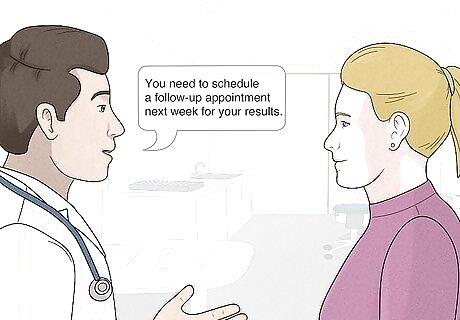
Wait for your results. The lab will have to run the proper tests on your blood sample before returning the results. Your doctor will typically ask you to schedule a follow-up appointment a week after you've had your blood drawn to go over your results.
Interpreting the Results
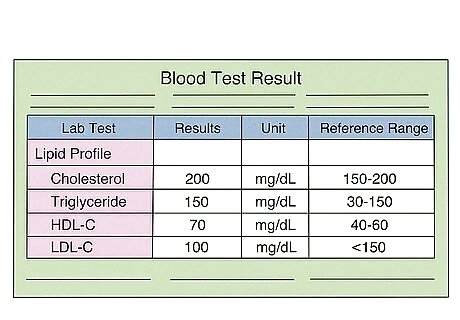
Read the measurements. Your cholesterol level will be provided as a concentration of cholesterol in your blood. The number refers to milligrams of cholesterol in a deciliter of blood (mg/dL). The lab may omit the unit of measurement on your results, but this is to what the numbers refer.
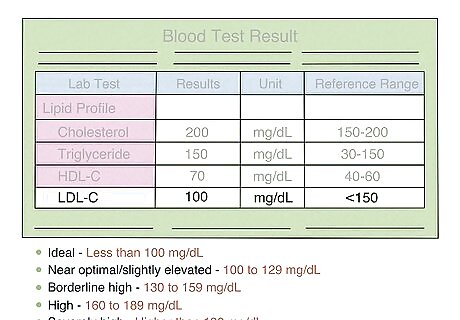
Assess your LDL level. Your doctor will consider an LDL level lower than 100 mg/dL ideal. The complete guidelines for LDL levels, for a person with no other medical conditions, are as follows: Ideal - Less than 100 mg/dL Near optimal/slightly elevated - 100 to 129 mg/dL Borderline high - 130 to 159 mg/dL High - 160 to 189 mg/dL Severely high - Higher than 190 mg/dL
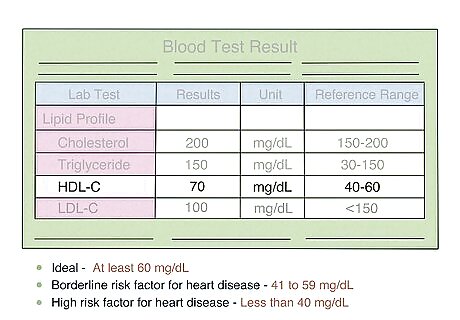
Examine your HDL level. You will see a separate number that indicates your HDL measurement. Your doctor will consider an HDL of 60 mg/dL (or greater) ideal. A breakdown of HDL measurements, for a man with no other medical conditions, is as follows: Ideal - At least 60 mg/dL Borderline risk factor for heart disease - 41 to 59 mg/dL High risk factor for heart disease - Less than 40 mg/dL Women's HDL ranges are not given here. Women should see their lab test or speak to their doctor to assess their proper ranges.
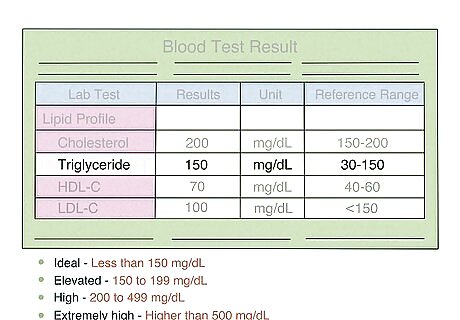
Assess your triglyceride level. Like high levels of LDL, high triglyceride levels can also increase your chances of atherosclerosis (artery narrowing and hardening), raising the risk of heart attacks and strokes. Your doctor will consider less than 150 mg/dL ideal, assuming you have no other medical conditions. The full breakdown of your triglyceride measurement is: Ideal - Less than 150 mg/dL Elevated - 150 to 199 mg/dL High - 200 to 499 mg/dL Extremely high - Higher than 500 mg/dL

Plug your numbers into the equation for total cholesterol. Once you have these three numbers, you can use them in a simple equation to calculate your total cholesterol. The equation is: LDL + HDL + (triglycerides/5) = total cholesterol. For instance, if you had an LDL of 100, HDL of 60, and triglyceride level of 150, then the equation would read: 100 + 60 + (150/5).

Calculate your total cholesterol. With all of your numbers plugged into the equation, you can simply perform the division and addition components to reach your total cholesterol level. For instance, calculating the previous example would be 100 + 60 + (150/5) = 100 + 60 + 30 = 190. You can also find online calculators that will tally your total cholesterol from the individual numbers.
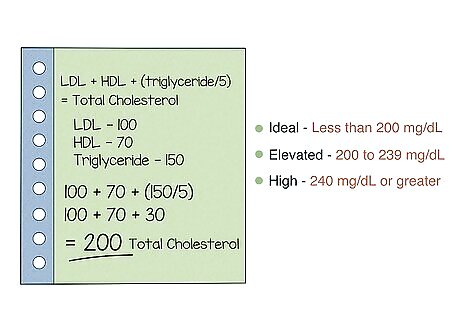
Assess your total cholesterol level. Similar to the individual components, your total cholesterol will fall into a range of readings from ideal to high. Your doctor will consider a total cholesterol reading of less than 200 mg/dL ideal, assuming you have no other medical conditions. However, the full range of readings is: Ideal - Less than 200 mg/dL Elevated - 200 to 239 mg/dL High - 240 mg/dL or greater

Have your doctor go over the results with you. While total cholesterol is a useful tool to have, you should still go over the component parts with your doctor because the number can be misleading. For instance, 99 LDL + 60 HDL + (200/5 triglyceride) = 199 total cholesterol. A total cholesterol level of 199 is not cause for alarm, but 200 is high for a triglyceride reading, and your doctor would still want to discuss options to help control your triglycerides.
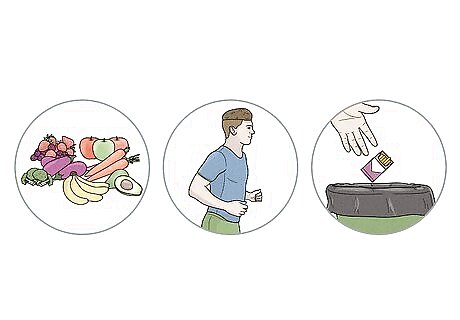
Take steps to lower your cholesterol. If any of your individual readings or your total cholesterol is out of the optimal range, then your doctor will likely recommend making lifestyle changes to help reduce your cholesterol. These steps include: Reducing saturated fats, trans fats, salt, and sugar in your diet Choosing healthy food options, such as fruits, vegetables, legumes, whole grains, and lean meat protein Getting at least thirty minutes of cardio exercise each day Quitting smoking (if applicable) Maintaining a healthy weight You can find complete information with steps for lowering your cholesterol at How to Unclog Arteries Naturally.

















Comments
0 comment